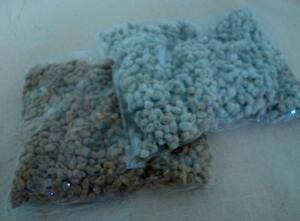
※The image shows a native Japanese cotton seed.
Native species may be unfamiliar to you, but they are species that have adapted to the local environment. Because they are rooted in the land, they are also called fixed species. This cotton seed is native to the Mikawa region of Japan.
The reason why we brought a species that has a completely different climate from Japan is because native cotton seeds were not available in Cambodia and surrounding countries.
Currently, the most common type of cotton is the F1 variety. They are also called hybrids. This means "one generation of hybrid".
If you look at a bag of vegetable, fruit, or flower seeds at a home improvement store, you will see that most of them are labeled as "XX hybrid" seeds.
Many of the vegetables, fruits, and flowers sold in supermarkets and grocery stores are also F1 hybrids. The benefits of these varieties are enormous. They produce varieties that consumers like: vegetables are bigger, fruits are sweeter, flowers are more colorful, and so on. This means that producers can also sell at a higher price. This point alone is a good thing.
But I am concerned about the situation where these F1 varieties dominate the market as they do today, and native varieties become hard to find. I have come to feel this strongly while growing cotton in Cambodia.
As the saying goes, F1 cotton is a "one generation hybrid," meaning that its characteristics last only one generation; if a cotton ball from an F1 cotton seed is planted the following year, it may not germinate at all, or the ball may be incomparably smaller than the previous year's. The second generation of F1 seed has completely different traits than the parent, which defeats the purpose of the original breeding. If vegetables are small, fruits are sour, and flowers are faded, consumers will not buy them.
Native species are not as remarkable in their characteristics as F1. Their characteristics as a species are preserved from generation to generation, from parent to child and from child to grandchild. In other words, it can survive as a species from generation to generation. This is proof that native species have survived over a long period of time, adapting to the local environment.
A "one-generation" F1 variety cannot pass life from one generation to the next. In other words, it is a non-circulating variety. In biology, one of the definitions of life is that "the essence of life is self-reproduction. In line with this definition, the question arises as to whether the F1 species created through artificial crossbreeding is a perfect life.
( to be continued )
